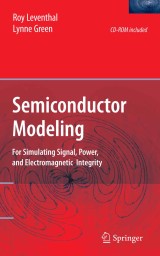Details

Semiconductor Modeling:
For Simulating Signal, Power, and Electromagnetic Integrity|
149,79 € |
|
| Verlag: | Springer |
| Format: | |
| Veröffentl.: | 10.01.2007 |
| ISBN/EAN: | 9780387241609 |
| Sprache: | englisch |
| Anzahl Seiten: | 768 |
Dieses eBook enthält ein Wasserzeichen.
Beschreibungen
<p><b>Semiconductor Modeling:</b> <b>For Simulating Signal, Power, and Electromagnetic Integrity</b> assists engineers – both recent graduates and working product designers – in designing high-speed circuits. The authors apply circuit theory, circuit simulation tools, and practical experience to help the engineer understand semiconductor modeling as applied to high-speed digital designs. The emphasis is on semiconductor modeling, with PCB transmission line effects, equipment enclosure effects, and other modeling issues discussed as needed. The text addresses many practical considerations, including process variation, model accuracy, validation and verification, signal integrity, and design flow. Readers will benefit from its survey of modeling for semiconductors, packages, and interconnects, along with usable advice on how to get complex, high-speed prototypes to work on the first try.</p><p>Highlights include:</p><p>- Presents a very complete and well-balanced treatment of modeling of semiconductors, packages, and interconnects. Facilitates reader comprehension of the whole field of high-speed modeling, including digital and RF circuits.</p><p>- Combines practical modeling techniques with the latest EDA tools for simulation and successful high-speed digital design. Facilitates resolution of practical, every-day problems.</p><p>- Presents modeling from its historical roots to current state of the art. Facilitates keeping abreast of the latest modeling developments as they continue to unfold. </p>
How the Workplace Supports Successful Design.- to Modeling Concepts.- Generating Models.- Model Properties Derived from Device Physics Theory.- Measuring Model Properties in the Laboratory.- Using Statistical Data to Characterize Component Populations.- Selecting Components and Their Models.- Using Selection Guides to Compare and Contrast Components.- Using Data Sheets to Compare and Contrast Components.- Selecting the Best Model for a Simulation.- Modeling and Simulation in the Design Process Flow.- About the IBIS Model.- Key Concepts of the IBIS Specification.- Using IBIS Models in What-If Simulations.- Fixing Errors and Omissions in IBIS Models.- Using EDA Tools to Create and Validate IBIS Models from Spice.- Managing Models.- Sources of IBIS Models.- Working with the Model Library.- Model Accuracy and Verification.- Methodology for Verifying Models.- Verifying Model Accuracy by Using Laboratory Measurements.- Balancing Accuracy Against Practicality When Correlating Simulation Results.- Deriving an Equation-Based Model from a Macromodel.- Future Directions in Modeling.- The Challenge to Ibis.- Feedback to the Model Provider Improves Model Accuracy.- Future Trends in Modeling.- Using Probability: The Ultimate Future of Simulation.
<P><STRONG>Semiconductor Modeling: For Simulating Signal, Power, and Electromagnetic Integrity</STRONG> gives designers and engineers a broad view of using semiconductor models to design high-speed circuit boards. Most issues in the field of designing high-frequency circuits, from the beginning of modeling and simulation using EDA tools to future trends, are discussed and integrated. </P>
<P>The main technical focus of <STRONG>Semiconductor Modeling: For Simulating Signal, Power, and Electromagnetic Integrity</STRONG> is the use of simulation to help solve practical engineering problems. The book draws on over 90 years of diverse technical experience and brings together theory, tools, components, software, and experience to help engineers create successful electronic products. </P>
<P>This book will help engineers understand how to approach problem solving while designing high-speed circuits. In particular, it helps engineers in the following areas:</P>
<P>· Encountering non-existent, incomplete, and erroneous semiconductor circuit models.</P>
<P>· Applying EDA tools to achieve practical designs despite model limitations.</P>
<P>· Grasping the basic high-speed digital, RF, and EMC design concepts that guide design intent.</P>
<P>· Applying EDA tools to cutting-edge digital technology.</P>
<P>· Working with suppliers, CAD team members, and others.</P>
<P>· Understanding the processes and procedures that enable and enhance the design process.</P>
<P> </P>
<P>The book presents the material in a manner that is helpful to circuit and product design engineers who have little or no specialized knowledge of high-speed digital design or semiconductors. </P>
<P>The main technical focus of <STRONG>Semiconductor Modeling: For Simulating Signal, Power, and Electromagnetic Integrity</STRONG> is the use of simulation to help solve practical engineering problems. The book draws on over 90 years of diverse technical experience and brings together theory, tools, components, software, and experience to help engineers create successful electronic products. </P>
<P>This book will help engineers understand how to approach problem solving while designing high-speed circuits. In particular, it helps engineers in the following areas:</P>
<P>· Encountering non-existent, incomplete, and erroneous semiconductor circuit models.</P>
<P>· Applying EDA tools to achieve practical designs despite model limitations.</P>
<P>· Grasping the basic high-speed digital, RF, and EMC design concepts that guide design intent.</P>
<P>· Applying EDA tools to cutting-edge digital technology.</P>
<P>· Working with suppliers, CAD team members, and others.</P>
<P>· Understanding the processes and procedures that enable and enhance the design process.</P>
<P> </P>
<P>The book presents the material in a manner that is helpful to circuit and product design engineers who have little or no specialized knowledge of high-speed digital design or semiconductors. </P>
Discusses process variation, model accuracy, design flow and many other practical engineering, reliability and manufacturing issues Gives a good overview for a person who is not an expert in modeling and simulation, enabling them to extract the necessary information to competently use modeling and simulation programs Includes supplementary material: sn.pub/extras
<P>This book assists engineers – both recent graduates and working product designers – in designing high-speed circuits. The authors apply circuit theory, circuit simulation tools, and practical experience to help the engineer understand semiconductor modeling as applied to high-speed digital designs. The emphasis is on semiconductor modeling, with PCB transmission line effects, equipment enclosure effects, and other modeling issues discussed as needed. The text addresses many practical considerations, including process variation, model accuracy, validation and verification, signal integrity, and design flow. Readers will benefit from its survey of modeling for semiconductors, packages, and interconnects, along with usable advice on how to get complex, high-speed prototypes to work on the first try.</P>


















